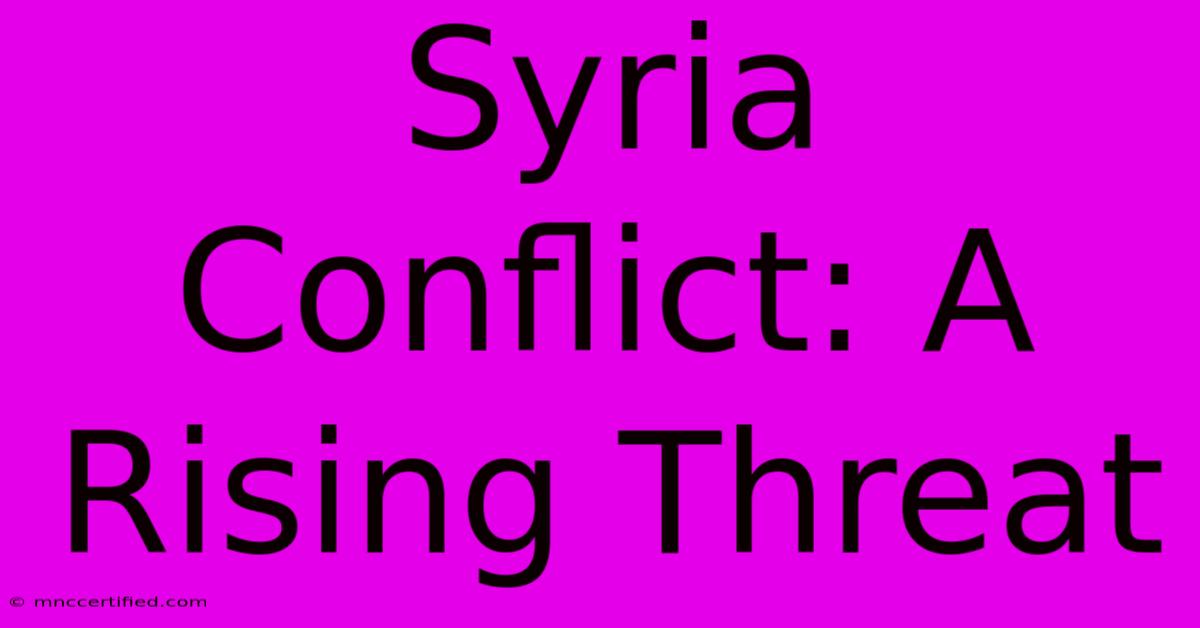Syria Conflict: A Rising Threat

Table of Contents
Syria Conflict: A Rising Threat to Regional and Global Stability
The Syrian conflict, which began in 2011, has evolved into a multifaceted crisis with far-reaching consequences. Initially sparked by pro-democracy protests, the conflict rapidly escalated into a brutal civil war, attracting numerous regional and international actors with diverse agendas. This article will explore the escalating threats posed by the ongoing Syrian conflict, examining its impact on regional stability, the humanitarian crisis, the rise of extremist groups, and the potential for wider international conflict.
The Humanitarian Catastrophe: A Continuing Tragedy
The human cost of the Syrian conflict is staggering. Millions have been displaced, both internally and externally, creating a massive refugee crisis that strains neighboring countries and international aid organizations. Millions more remain trapped within Syria, facing daily threats of violence, starvation, and disease. The destruction of infrastructure, including hospitals and schools, has crippled essential services, leaving millions vulnerable and exacerbating existing inequalities. The ongoing humanitarian crisis requires urgent and sustained international intervention, but access for aid workers remains severely limited due to ongoing conflict and political obstacles. This lack of access only serves to heighten the suffering and instability.
Key Humanitarian Challenges:
- Access to Aid: Restricted access for humanitarian organizations hinders the delivery of essential aid to those most in need.
- Displacement and Refugee Crisis: The sheer number of displaced persons places an immense strain on resources and infrastructure in neighboring countries.
- Food Insecurity: Widespread food shortages contribute to malnutrition and exacerbate existing vulnerabilities within the population.
- Healthcare Collapse: The destruction of healthcare facilities and the shortage of medical personnel create a dire healthcare situation.
The Rise of Extremist Groups: A Breeding Ground for Terrorism
The chaotic environment in Syria has provided fertile ground for the proliferation of extremist groups, most notably ISIS (Islamic State of Iraq and Syria). While ISIS has lost its territorial control, its ideology continues to inspire attacks globally, posing a significant threat to international security. Other extremist groups also operate within Syria, further destabilizing the region and contributing to the ongoing violence. The protracted conflict and the power vacuum have allowed these groups to recruit, train, and plan attacks, extending their reach beyond Syria's borders. The threat of terrorism emanating from Syria remains a serious concern requiring a concerted global counter-terrorism strategy.
Understanding the Extremist Threat:
- ISIS remnants: Though territorially defeated, ISIS maintains a significant presence through sleeper cells and affiliated groups.
- Other extremist factions: A multitude of extremist groups, with varying ideologies, operate within Syria, creating a complex and dangerous security landscape.
- Global reach: Extremist groups based in Syria use the internet to spread propaganda and recruit fighters globally, posing a transnational security threat.
Regional Instability: Spillover Effects and Proxy Conflicts
The Syrian conflict has significantly destabilized the region, triggering proxy conflicts between regional and international powers. Neighboring countries have been directly impacted by the influx of refugees, the spillover of violence, and the involvement of their own citizens in the fighting. The conflict has also exacerbated existing regional tensions, fueling rivalries and contributing to the broader instability across the Middle East. This regional instability has far-reaching implications, including the potential for wider conflicts and humanitarian disasters.
Regional Impact:
- Refugee crisis: The massive influx of refugees places a strain on the resources and infrastructure of neighboring countries.
- Proxy conflicts: Regional and international powers are involved in the conflict through their support of different factions, exacerbating the violence.
- Increased tensions: The conflict has further inflamed existing regional rivalries, leading to increased instability and potential for further conflict.
The Path Forward: Challenges and Opportunities
Resolving the Syrian conflict requires a multifaceted approach involving political negotiations, humanitarian aid, and sustained international cooperation. However, the complexities of the situation, the deep-seated divisions within Syria, and the involvement of numerous international actors make finding a lasting solution extremely challenging. Finding a lasting peace in Syria requires a comprehensive strategy that addresses the root causes of the conflict and promotes reconciliation, but this is a long and arduous process with no guaranteed outcome. The international community must remain engaged and committed to finding a peaceful resolution, while also addressing the humanitarian crisis and the threat of terrorism.
In conclusion, the Syrian conflict remains a significant threat to regional and global security. The humanitarian crisis, the rise of extremist groups, and the regional instability highlight the urgent need for a comprehensive and sustained international effort to address this complex and devastating conflict. Ignoring the escalating threats posed by the Syrian conflict will only exacerbate the human suffering and increase the risks of further instability and violence.

Thank you for visiting our website wich cover about Syria Conflict: A Rising Threat. We hope the information provided has been useful to you. Feel free to contact us if you have any questions or need further assistance. See you next time and dont miss to bookmark.
Featured Posts
-
Janey Godleys Farewell In Glasgow
Nov 30, 2024
-
Air Pods Pro 2 119 Black Friday Deal
Nov 30, 2024
-
Sephora Black Friday 2024 50 Off Deals
Nov 30, 2024
-
Kc Welcomes Back Pacheco
Nov 30, 2024
-
Elon Musk And Shiba Inu Coin
Nov 30, 2024